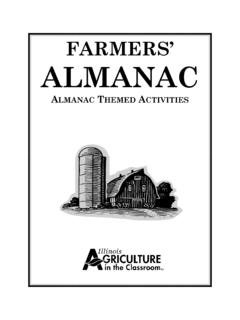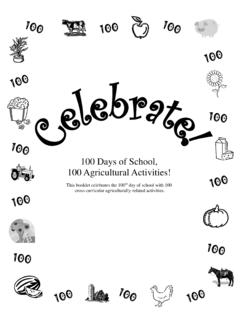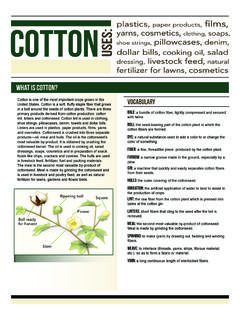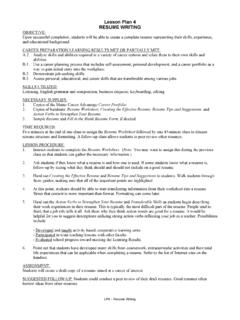Transcription of IAITC Horse Lesson Booklet - Illinois AITC
1 IAITC Horse Lesson Booklet Activities to Complement the Horse Ag Mag! 2 horses have been useful animals for thousands of years. The Horse has served human beings as a very important tool in progressing with the times. It was once stated, history was written on the back of a Horse . horses were a fixture of many ancient civilizations. horses enabled faster commu-nication, travel, proved excellent allies in war and helped to transform agri-culture. In this Booklet , the Horse will again serve us by allowing an inter-esting avenue for students to practice areas of science, social studies, and math. This Booklet is designed with the student audience in mind. These activities are intended to be used in the classroom as supplemental learning material. Each Lesson is correlated to the Illinois State Learning Standards and As-sessment Framework. The answer sheet for each activity is provided at the end of this Booklet .
2 A visual key has also been created and used with each activity to indicate its subject area. The topics include: hands-on, science, health and nutrition, reading , math, social studies, writing, and art. Hands-on Math Science Writing Art Social Science Reading Health and Nutrition 3 The Reading Ranch Pages 4-9 Illinois Learning Standards: Reading: ; ; ; Illinois Assessment Framework: ; ; ; A Hand some Horse Pages 10-13 Illinois Learning Standards: Math ; ; ; ; Illinois Assessment Framework: ; ; ; ; ; ; ; A Horse of a Different Color Pages 14-16 Illinois Learning Standards: Reading ; , Writing ; ; ; Illinois Assessment Framework: ; ; ; ; ; Hoofing it Through History Pages 17-24 Illinois Learning Standards: Social Science ; ; ; ; ; Geography Illinois Assessment Framework: ; ; ; ; ; ; ; El Caballo (The Horse ) Pages 25-27 Illinois Learning Standards: Social Studies and English Language Arts ; Geography Illinois Assessment Framework.
3 A Work Horse Pages 28-29 Illinois Learning Standards: Math ; ; ; Illinois Assessment Framework: Not available 4 The Reading Ranch grade Level: 4-6 Social Studies & Reading Objective: After completing this activity, students should become more familiar with the for-mat of a short reading passage followed by multiple choice questions found on the Illinois Standards Achievement Exam (ISAT). Illinois Learning Standards: Reading: ; ; ; Assessment Framework: ; ; ; Suggested Reading Materials: IAITC Horse Ag Mag Pony Express! By Steven Kroll ISBN-10: 0590202405 They re Off: Story of the Pony Express By Cheryl Harness ISBN-10: 0689851219 Introduction: This Lesson was designed to resemble a short reading passage that could be found on the ISAT test. The excerpt was created from several sources pertaining to the history of the Pony Express.
4 Have students read the passage and answer the questions that follow. Lesson Extender! 1. To further students knowledge of the Pony Express create a classroom PowerPoint that highlights some of the significant figures that ran the Pony Express routes. Significant figures to search could be, but are not limited to: William Russell, Alexander Majors, Johnny Fry, Thomas Thornhill Willson (who was from DeKalb, Illinois ) and William Waddell. The following web-site will be helpful in finding Pony Express Riders: #HICKOK 2. After studying the history of the Pony Express, have students pretend they are one of the riders that was responsible for delivering President Lincoln s inaugural speech. Have them com-pose a poem or short story to describe what adventures they had while delivering the speech. Each student would represent a leg of the trip to deliver the speech to Lincoln. Have them share with the class or make a display with their writings.
5 5 The Pony Express 1 In the 1860 s there were no such things as cell phones and computers for email. Imagine living on the west coast of the United States and trying to get important information to the east coast. Communication in the time of the 1860 s was virtu-ally impossible. It took a post card more than a month to travel across the states. Most mail was delivered with the help of cov-ered wagons pulled by horses or mules. Weather conditions and threats of attack only made de-livering the mail more difficult and slower. 2 The idea of an express mail system was developed by William Russell, Alexander Majors, and William Waddell. The three men were promised a million dollar grant from the United States government to start the mail sys-tem that would help the govern-ment communicate faster. 3 The Pony Express was set up to be a Horse relay. The goal of the Pony Express was to keep the mail moving day and night.
6 It allowed mail to travel from the East to California in just eight days compared to the months it had taken before. 4 The relay system worked by having each rider and Horse gal-lop at high rates of speed for distances of ten to fifteen miles. It was believed that most horses traveled at about 10 mph. At each stop a rider would receive a fresh Horse and continue on. There was said to be about 165 relay stations and each rider was to stop at six to eight stations be-fore they turned the mail over to a new rider. 5 The men and horses worked as a team to ensure that the mail was delivered quickly and safely. The fastest delivery was said to contain President Lincoln s inau-gural speech and it took 7 days and 17 hours. 6 A To allow people to be able to send mail. B To make it safer to send mail. C To create a faster way to deliv-er mail. D To create more jobs for people in California.
7 A 155 B 160 C 165 D 175 A A telegram containing important Civil War information. B An important weather forecast. C A check for William Russell. D President Lincoln s inaugural speech. A William Russell B Abraham Lincoln C Alexander Majors D William Waddell The fastest delivery recorded by the Pony Express was delivering what piece of information? Which of the following men was NOT involved in the creation of the Pony Express? 1 2 3 4 Why was the Pony Express creat-ed? How many relay stations were set up for the Pony Express riders? Name_____ Today s Date_____ 4th grade 7 A Not able to happen. B Almost but not quite. C Can not happen without help. D Completed. A Defeated B Disregarded C Established D Separated A Tr ue B False A Nonfiction B Fiction C Humor D Biography Tr ue or False The Pony Express was set up to be a relay system that kept the riders going day and night.
8 This writing is best described as which of the following writing styles? 5 6 7 8 What does virtually mean as it is used in paragraph 1? What word could replace developed in paragraph 2? Name_____ Today s Date_____ 4th grade 8 A Narrative B Persuasive C Expository D Descriptive A Rested and then waited for the return mail so they could ride back towards home. B Ride back home without mail. C Set up a new home at the lo-cation where they stopped. D Walk back to their starting location. A By Train B By Mailman on foot C In a covered wagon pulled by horses and mules D By automobile A Fast B Slow C Quick D Speedily How was the mail delivered before the Pony Express? What is the antonym for Express in the sentence below? The men developed the idea for an express mail system. 1 2 3 4 Which type of writing is this passage? What did riders most likely do after their route was completed?
9 Name_____ Today s Date_____ 6th grade 9 A The inventors of the Pony Ex-press. B How the Pony Express was set up and where it traveled. C The fastest delivery ever made by the Pony Express. D How fast the riders went. A Research it on the Internet. B Interview a Pony Express rider. C Read a book about the Pony Express. D Both A and C would be ways to obtain more infor-mation. A To give riders a break. B To pick up more mail. C To allow riders to switch to a fresh Horse . D So riders would not get lost on the trail. A A young Horse B A clean Horse C A trained Horse D A rested and ready to run Horse Why did the Pony Express have 165 relay stations? What does the word fresh mean in the sentence below? At each stop a rider would receive a fresh Horse and continue on the trail. 5 6 7 8 Paragraph 3 of this selection is mainly about To learn more about the Pony Express a reader could - Name_____ Today s Date_____ 6th grade 10 A Hand some Horse grade Level: 4-6 Math Objective: After completing this activity, students will be more familiar with the unit of measurement called hands that is used to determine a Horse s height.
10 Students will have al-so practiced reading rulers and making measurement conversions. Illinois Learning Standards: Math ; ; ; ; Assessment Framework: ; ; ; ; ; ; ; Suggested Reading Materials: IAITC Horse Ag Mag 50 Fabulous Measurement Activities by Martin Lee ISBN-10: 0590644068 Introduction: horses are measured in units called hands. One hand represents 4 inches. The origin of measuring a Horse this way is very old, but easy to understand. In days long ago people did not have the common measuring devices like tape measures. To measure a Horse , they used what was available. At various times in history and in different locales, a "hand" was defined as the width of a person's hand using the fingers only, the width of a person's hand using the fingers and the thumb, the height of a clenched fist, and possibly many others. Somewhere along the way, the measuring unit of a hand was standardized to mean four inch-es.












